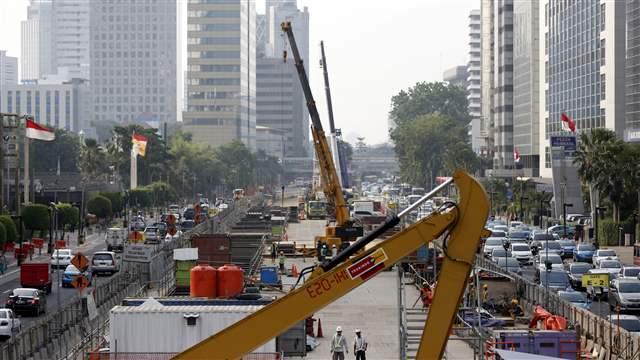The agendas of accelerating sustainable development
and eradicating poverty and that of climate change
are deeply intertwined. Growth strategies that fail to
tackle poverty and/or climate change will prove to be
unsustainable, and vice versa. A common denominator
to the success of both agendas is infrastructure
development. Infrastructure is an essential component
of growth, development, poverty reduction, and environmental
sustainability.
The world is in the midst of a historic structural
transformation, with developing countries becoming
the major drivers of global savings, investment, and
growth, and with it driving the largest wave of urbanization
in world history. At the same time, the next 15
years will also be crucial for arresting the growing
carbon footprint of the global economy and its impact
on the climate system.
A major expansion of investment in modern, clean,
and efficient infrastructure will be essential to attaining
the growth and sustainable development
objectives that the world is setting for itself. Over the
coming 15 years, the world will need to invest around
$90 trillion in sustainable infrastructure assets, more
than twice the current stock of global public capital.
Unlike the past century the bulk of these investment
needs will be in the developing world and, unlike the
past two decades, the biggest increment will be in
countries other than China.
Getting these investments right will be critical to
whether or not the world locks itself into a high- or
low-carbon growth trajectory over the next 15 years.
There is powerful evidence that investing in lowcarbon
growth can lead to greater prosperity than a
high-carbon pathway.
At present, however, the world is not investing what
is needed to bridge the infrastructure gap and the
investments that are being made are often not sustainable.
The world appears to be caught in a vicious
cycle of low investment and low growth and there
is a persistence of infrastructure deficits despite an
enormous available pool of global savings. At the
same time, the underlying growth trajectories are
not consistent with a 2 degree climate target. And climate
change is already having a significant impact,
especially on vulnerable countries and populations.
The current infrastructure investment and financing model needs to be transformed fast if it is to enable the quantity and quality of growth that the world economy needs.
Yet there are major opportunities that can be exploited
to chart a different course. The growth potential of developing countries can be harnessed to boost their own development and global growth and demand. Long-term interest rates are at record lows and there are major untapped sources of finance. Technology change offers prospects for breakthroughs on development and climate outcomes (smart cities, distributed solar power). And there is growing recognition of the importance of decarbonization and new commitments to it by advanced countries as well as developing countries.
The current infrastructure investment and financing model needs to be transformed fast if it is to enable the quantity and quality of growth that the world economy needs. The urgency of action cannot be overemphasized. Given the already high level of emissions, the next 15 years will be a crucial period and the decisions taken will have an enduring impact on both development and climate outcomes. The forthcoming U.N. Conference on Financing for Development at Addis Ababa in July provides a historic opportunity to reach consensus on a new global compact on sustainable infrastructure. To this end, the paper proposes six critical areas for action:
First, there is a need for national authorities to clearly articulate their development strategies on sustainable infrastructure. These strategies need to address the still considerable opportunity for improvements in national policy in key infrastructure sectors, such as urban development, transport, and energy. There is a need for stronger institutional structures for investment planning and for building a pipeline of projects that take into account environmental sustainability from the outset, and greater capacity to engage with the private sector.
Second, the G-20 can play an important leadership role in taking the actions needed to bridge the infrastructure gap and in incorporating climate risk and sustainable development factors more explicitly in infrastructure development strategies. The G-20 can do this through their own actions and investment strategies and by supporting global collective actions such as the development of norms for sustainable procurement and unlocking both public and private pools of finance. The Global Infrastructure Forum proposed in the draft Addis Accord can build on the G-20 and other initiatives to create a global platform for knowledge exchange and action.
Third, the capacity of development banks to invest in infrastructure and agricultural productivity needs to be substantially augmented in order for them to pioneer and support changes needed for better infrastructure. In our view, MDBs will need to increase their infrastructure lending five-fold over the next decade, from around $30-40 billion per year to over $200 billion, in order to help meet overall infrastructure financing requirements. Several MDBs have taken steps and are actively considering options to enhance their role and capacity. The establishment of new institutions and mechanisms also creates the opportunity for greater flexibility and scale. Nevertheless, a more systematic review of the role of MDBs and needed changes could help strengthen their individual and collective roles and garner support from shareholders and other stakeholders.
Fourth, central banks and financial regulators could take further steps to support the redeployment of private investment capital from high- to low-carbon, better infrastructure. We already see progressive action from the Bank of England and the French government. Market-developed standards for instruments such as green bonds could also increase the liquidity of better infrastructure assets.
Fifth, the official community (G-20, OECD, and other relevant institutions) working with institutional investors could lay out the set of policy, regulatory, and other actions needed to increase their infrastructure asset holdings from $3-4 trillion to $10-15 trillion over the next 15 years. This could include publishing project pipelines, standardizing contracts, providing government-backed guarantees for investments in sustainable infrastructure, and making longer-term policy commitments in terms of tax treatment of infrastructure investments. “Impact capital”—capital that is willing to take lower ex ante returns in exchange for significant reductions in policy risk is growing rapidly and could make a significant contribution.
Sixth, over the coming year the international community should agree on the amounts of concessional financing needed to meet the SDGs, how to mobilize this financing and how best to deploy it to support the economic, social, and environmental goals embodied in the SDGs. ODA can play a critically important role in crowding in other financing and in enhancing the viability of infrastructure projects. Beyond ODA, targeted climate finance, when combined with the much larger pools of private and non-concessional public financing, could offset additional upfront costs of low-carbon investments in both low- and lower-middle income countries and help build more resilient infrastructure and help adapt to climate change. The Green Climate Fund (GCF) is a first possible step around which such a new approach can be built.
We know the main elements of the transformation agenda, although many details have to be worked out. They are entirely compatible with both sustainable development and climate goals. The aim is not to put in place complex and burdensome structures but responsive and flexible mechanisms capable of learning and bringing about real change. Working together across the Financing for Development, SDG, G-20, and UNFCCC processes, there is an opportunity to drive real change over the next 12 months.
Achieving better infrastructure outcomes will require concerted actions on many fronts. But moving from a business-as-usual approach to better infrastructure can dramatically affect global outcomes on both development and climate.
The Brookings Institution is committed to quality, independence, and impact.
We are supported by a diverse array of funders. In line with our values and policies, each Brookings publication represents the sole views of its author(s).





